#new construction interior design services
Text
Interior Designer Near Me: Finding the Right Fit for Your Home

Are you looking for a local interior designer near me? Finding the correct match might be crucial, whether you’re looking for a comprehensive remodel or simply a few adjustments. But how do you decide when there are so many options available?
Start by taking your style and budget into account. Do you favor the traditional, the modern, or a combination of the three? What are you willing to pay? Following your responses to these inquiries, you can start looking for the ideal interior designer.
Asking friends or family for referrals is one technique to locate a local interior designer. Ask the architect of a space you like if you’ve seen one. Additionally, you can look up local interior designers online and read client testimonials.
Schedule a consultation with your shortlisted designers after you’ve done your research. This is a fantastic chance to get to know the designer and determine whether your personality and aesthetic preferences blend well. Make sure to inquire about their design methodology, background, and portfolio.
Interior Design Trends 2023
It’s time to talk about the newest interior design trends now that you’ve located an interior designer close by. The following are some of the most well-liked trends that 2023 is expected to see:
1. Sustainable Resources
Sustainable materials are increasingly being used in interior design as consumers become more ecologically conscious. Furniture and décor will increasingly be made of natural and recyclable materials like bamboo, cork, and reclaimed wood.
2. Warm hues
Warm colors like terracotta, rust, and ochre are reemerging in the design industry after years of colder tones predominating. Any room is made to feel cozy and welcoming by these earthy tones.
3. Maximalism
Maximalism is finally gaining the stage after years of minimalism dominating fashion. Eclectic and lively interiors are being created by utilising strong patterns, textures, and colors.
4. Biological Design
The whole point of biophilic design is to bring the outside in. In order to achieve a relaxing and peaceful ambiance, this trend emphasizes adding natural elements such as plants, water features, and natural lighting into home design.
5. Multipurpose Spaces
The popularity of multi-functional workplaces is rising as more individuals choose to work from home. Making rooms that may serve several uses, such a home office that also serves as a guest room, is a current trend.
In conclusion, the secret to building the house of your dreams is choosing a local interior designer who is familiar with your taste and budget. You can make sure your place is fashionable and useful by staying current with interior design trends. There is a trend out there for everyone, whether you favor eco-friendly materials, cozy hues, maximalism, biophilic design, or multifunctional spaces. What are you still holding out for? Begin looking for the ideal interior designer right away!
#design interior modern#modern classic interior design#new construction interior design services#interior design trends 2023
2 notes
·
View notes
Text

Elevate your homeownership experience in Sydney with Grange Building, recognized as the best home builders in sydney. Our commitment to quality craftsmanship and personalized service ensures your dream home becomes a reality. Explore unparalleled expertise and turn your vision into a home that stands out among the best in Sydney.
Visit: https://www.grange-building.com.au/
Grange Building PTY LTD 31A Baden St, Greystanes NSW 2145,Australia
Call: +61418 260 087
#Best Home builders in Sydney#Best Interior Design in Sydney#Building Construction Management in Sydney#Building Construction Service NSW#Modern Home Renovation in Sydney#New Home Builder in Sydney#Grange Building
1 note
·
View note
Text
Transitional Kids in New York

Inspiration for a large transitional gender-neutral kids' room remodel
0 notes
Photo

Bathroom Kids in New York
Example of a mid-sized transitional kids' white tile and marble tile mosaic tile floor bathroom design with glass-front cabinets, white cabinets, quartz countertops and white countertops
#full service interior design#luxury furniture#interior design#new construction#girls bathroom#custom vanity#whole house design
1 note
·
View note
Photo

Kids Bathroom
Bathroom: A spacious transitional kids' bathroom with a mosaic tile floor and recessed-panel cabinets in blue and white.
0 notes
Photo

Natural Pool San Francisco
Inspiration for a mid-sized contemporary front yard custom-shaped natural pool fountain remodel with decking
#green design#interior remodel#modern art collection#sustainable living#new construction#full service design
0 notes
Photo

Transitional Kids in New York
Inspiration for a large transitional gender-neutral kids' room remodel
1 note
·
View note
Text
Kids in New York
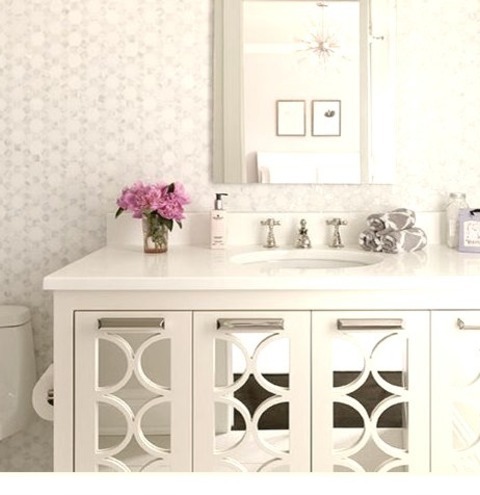
An illustration of a mid-sized transitional kids' bathroom with white tile, marble tile, glass front cabinets, white countertops, and quartz countertops.
#new construction#interior design#full service interior design#whole house design#luxury furniture#custom vanity#bathroom
0 notes
Text


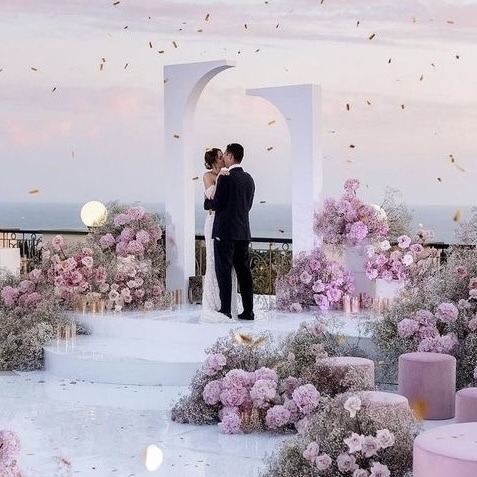

Your Future Spouses Job
Due to derivative astrology the 4th house rules over our future spouses career. Here are some possible careers your spouse could have with each 4th house placement. Remember that there can be more interpretations than this, but these are only some examples

Aries 4h: Firefighter, athlete, rapper, race car driver, fighter (example: ufc fighter), cop, military soldier/veteran, er dispatcher, personal trainer/bodybuilder, entrepreneur
Taurus 4h: Chef, accountant, banker, singer, podcaster, sales worker, radio host, fashion designer/stylist, model, botanist, financial manager, financial clerk, food service manager, marketing manager, cashier
Gemini 4h: Writer/journalist/poet, social media influencer, teacher, comedian, podcaster, politician, radio host, public speaker, librarian, videographer, counselor, game designer, tutor, neurologist, driver (examples: door dasher, bus driver, uber driver, etc)
Cancer 4h: Baker, real estate agent, nurse, nanny (example: travel nanny), home/interior designer/architect, marine biologist, carpenter, construction worker, counselor, professional cuddler
Leo 4h: Actor, entertainer, athlete, talent agent/director, event/party planner, theatre teacher, music teacher, hair stylist/barber, concert promoter, any career involving fame
Virgo 4h: Doctor/nurse, nutritionist, vet, comedian, news reporter, interviewer, personal trainer, therapist, lawyer, farmer, librarian, botanist, housekeeper/maid, counselor, tutor, dentist, dermatologist, neurologist, zoologist, social media influencer
Libra 4h: Singer, dancer, model, artist, fashion designer/stylist, wedding planner, makeup artist, lawyer, dermatologist, barber/hair stylist
Scorpio 4h: Detective, cop, psychologist, funeral director, coroner, banker, sex worker (example: stripper), tax preparer, bikini waxer, forensic pathologist, criminal psychologist
Sagittarius 4h: Teacher, comedian, pilot, flight attendant, astrologer, news reporter, casting agent, religious career (example: pastor), lawyer, librarian, philosopher, photographer, interpreter/translator, tutor, tour guide
Capricorn 4h: Business owner/ceo, film director, publicist, archeologist, politician, entrepreneur, historian, financial manager, carpenter, construction worker, chiropractor, dentist, sales agent
Aquarius 4h: Engineer, scientist, rapper, social media influencer, film producer, inventor, dj, humanitarian, politician, graphic designer, entrepreneur, videographer, game designer, electrician
Pisces 4h: Singer/musician, actor, astrologer, psychic, hypnotist, astronomer, artist, model, lifeguard, marine biologist, creative writer, lyricist, any career involving fame


#future spouse astrology#predictive astrology#4th house#derivative astrology#birth chart#astrology#astrology blog#astrology community#astro community#astrology chart#astrology tutorial
2K notes
·
View notes
Text
Home Make Over/ Home Improvement Ideas Dubai
Home Makeover and Interior Design Ideas Dubai
Do you feel your home started looking tedious? This is the exact time for some small budget big makeover ideas to make your home a little more thrilling? You ever think that the space you live in decide your mood? It has a heavy impact on your personality also. Well, you don’t have to worry about to get a home that warrants your dream come true moment. It is just a matter of going for the right home improvement idea that is perfect for you. Here are some home makeover ideas that give your home and interiors a unique look.
Home Make Over/ Home Improvement Ideas Dubai
Add Wall Arts and Creative Hangings
Nothing is impressive in keeping plain wall so it will be alluring when we add wall arts and creative hangings to the plain wall. So that we can make a space on your entire wall with art.
Color-block Home Furniture
It is most popular interior design technique that involves pairing two or more bold colors together. This idea does not require a heavy investment and can be achieved even if you have a modest budget.
Put on Wallpapers in Interior
We can go for 3D wallpapers that actually have a dimensional finish or traditional and modern 2D wallpapers. Putting on wallpapers is a very budget-friendly idea for while giving a home makeover.
Install Tiles to Improve Flooring
When entering to any house the first thing we are noticing is its flooring. While choosing tiles, we have to keep in mind that it will affect the entire budget so make sure choosing the tiles that will fit within our budget.
Remove Partial Walls and Blockage to Improve Spacious
Removing partial and unnecessary blockage spaces will make home look bigger and spacious. And by removing these unnecessary blockages will help to get free spaces.
Add Plants and Greenery to Home Interior and Exterior
Well, adding greenery to any room instantly gives a fresh feeling to the space and adds color and texture. Visit any nearest plant nursery and choose green plants and small shrubs which is perfect for our home interior.
Change Your Lighting Settings
Home lighting is a very important aspect while making an attractive home space. Further to this we can choose warm lights for a comfortable home space and white lights for official spaces.
Add Accessories to Your Home Interior
These are accessories which include items like curtains, sofa sets, cushions, tablecloths and decorative craft products, decorative and so on. These items are mainly used in indoor furnishings and can include paintings.
Add Decorative Accessories to Your Home
These are accessories which include items like curtains, sofa sets, cushions and other decorative items. These accessories are mainly used in indoor furnishings and interior decoration.
Rearrange Your Home Interior
Rearrange the home is something which gives a different outlook to home interior for example changing the furniture position to a different location will surely make your home look different and unique from what it was before.
For better home makeover and Interior Design Services in Dubai, contact Design Mart Contracting LLC based in Dubai, UAE. We will help you to transform your home into a visual masterpiece with our professional interior designers. Contact +971 4 224 8843 or write to [email protected].
#interior design#architecture#residential architects#home improvement#new home#home décor#Interior Design Services in Dubai#Best interior design companies in Dubai Interior design companies in Dubai Interior design companies Interior decorators in UAE Construction
1 note
·
View note
Text
Design of Midhope Distillery
The parts of document I'm showing in this post was presented and designed on June 26, 2020

EXECUTIVE SUMMARY
This Design and Access Statement accompanies a Planning Applica- tion for a new Single Malt Scotch Whisky Distillery at Midhope Castle which lies within the Hopetoun Estate on the outskirts of Edinburgh. It is intended this is the first of a series of applications containing proposals to regenerate the Castle, the surrounding listed buildings and landscape setting.
The overall project aims to create an environment to produce, share and market an exceptional whisky. Its success depends not just on the production of whisky but on the ability to invite guests to see the creative process, appreciate its origins and have the time to experi- ence the whisky and the environment. It is intended in the future that the castle will be the venue for a significant part of these activities.
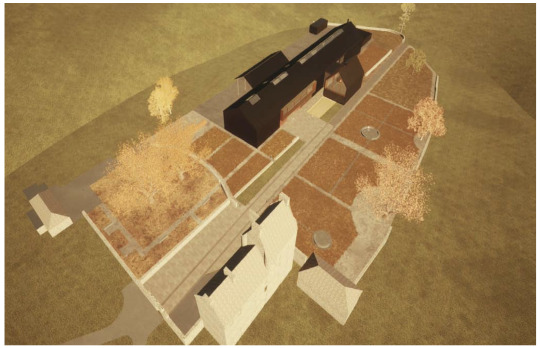

Note, the clients Golden Decanters and Hopetoun estate are the original applicants. Golden Decanters changed their company name since April 2022
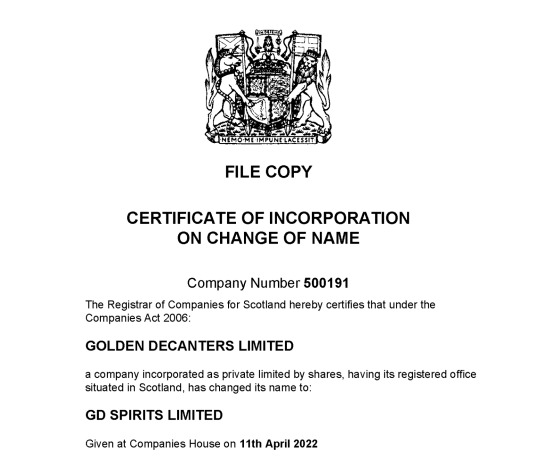
Design Team
Project Manager - Curries & Brown
Currie & Brown works across the public and private sectors, including commercial property, consumer goods, defence, education, funding institutions, government, healthcare, high-tech, hospitality and leisure, industrial, mixed-use developments, nuclear, pharmaceuticals and life sciences, PPP/P3, residential property, retail, trans- portation and logistics and utilities and renewables. wWith our global reach, Currie & Brown brings together a large group of talented professionals to offer our clients a comprehensive range of the services, experience and expertise, together with a significant value added offering.
Planning Consultant - Scott Hobbs Planning
Scott Hobbs Planning (SHP) is an established planning and development consul- tancy founded in 2004, servicing clients throughout the British Isles, for major mixed use, commercial, retail and residential development. The practice has wide ranging and detailed experience in all aspects of planning-related work including national policy shaping, development planning and development management; development framework and master-planning; and consultation processes.
Architect - 56three Architects
56three is a design based Practice with projects covering new build, conservation and refurbishment works throughout the UK.
We have an award winning team of architects, technicians and interior design- ers who are able to provide the full range of architectural services from feasibility through to construction.
Landscape Architect - rankin fraser landscape architects
rankinfraser landscape architecture llp was formed in January 2008. Based in Edin- burgh, Scotland the practice brings together Chris Rankin and Kenny Fraser – two Landscape Architects with over 30 years combined experience of delivering award winning projects from conception through to completion
We combine practice with research and teaching to provide our clients with a thoughtful, creative and professional approach to landscape design and place mak- ing covering public realm, landscape urbanism, housing landscapes, education and health projects in urban and rural situations.
LOCATION
The site is approximately 11.5 miles West of the City of Edinburgh, 5 miles to the North West of Edinburgh airport, 3.5 miles to the West of the South Queensferry, and a little under half a mile South of the Firth of Forth. It has an overall area of 6.9 hectares within the beautifully managed Hopetoun Estate. Hopetoun House is approximately 1 mile East of the site.

SITE
The site is located within Hopetoun Estate but outside the area of the Designated Designed Landscape that surrounds Hopetoun House and Abercorn to the east. The site for the new distillery is located to the immediate west of Midhope Castle.
The Castle is reached via an access road runs for approximately a quarter of a mile, west from the road link between the hamlet of Ab- ercorn and the A904.
The site to the east of the Midhope Burn is largely dense woodland. A Fireworks manufacturing business is currently located in a large clearing near the entrance to the site. This clearing was formerly the location of a Saw Mill.
The access road arrives at a small car park. There is a path that leads to the outer wall of the Castle courtyard.

Midhope Castle is to the north-east of the site with a courtyard and a modest walled garden to the immediate South. Behind the castle, just to the north, is a small derelict Victorian, ancillary building.
In the space to the east of the castle toward the approach road there are two Victorian cottages and a doocot.
The site for the distillery building is to the south-west of the cas-
tle and in an area that is currently occupied by a number of modern agricultural sheds and some hard-standing left from recent utilitarian ancillary structures. The area is functional and has no obvious sig- nificant historic structures. It currently houses the grounds for a tree climbing and chainsaw training company which is in the process of relocating.
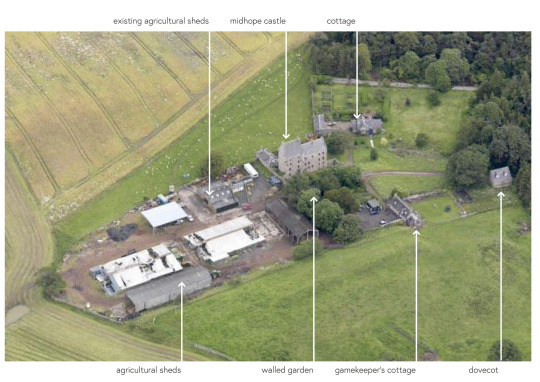






HERITAGE CONTEXT
The original Midhope Castle (recorded as “Medhope Castle”) was built in the late 15th century. In 1587 this castle was partially rebuilt.
The castle was extended in 1664 and reached the general arrange- ment and form that can be seen today. Further extensions and altera- tions took place in 1678.
By the early 20th century the castle was in a state of disrepair and the interior timber staircase recorded as being in poor condition.
In 1988 a programme of consolidation and partial restoration was undertaken. A new roof was formed on the West Tower and steelwork was inserted within the shell of the castle to stabilse the structure. New window frames were inserted into the existing openings. This work seems to have arrested any further significant deterioration.
Today the building is in a ruinous state internally, and most of the in- ternal features have been lost, but is generally wind and water tight.
Midhope Castle was designated as a Scheduled Monument in 1950 and was given a Category A listing in 1971 . In 2018 the Scheduled Monument status was removed and the designation was simplified to the current Category A listing.


The Roy Lowlands map of 1754 shows the castle within the wider context of the Hopetoun House Estate. To the north of the castle are a series of geometrically arranged copses either side of an axis that relates to Hopetoun House to the west. Today some of these trees are still visible.
The landscape around Midhope Castle is also visible on this plan - the series of walls that form the courtyard at the castle, and the larger open area to the west.

The 6 inch map of 1854 more shows Midhope Castle in the form that it can be seen today. The approach path from the east, the Doocot, the gamekeeper’s cottage and the walled garden to the south of the castle are visible.
This plan also shows the state of the landscape to the west of the castle. A path or track extended out from the courtyard into the land- scape and a series of gardens were enclosed to the north.
The south edge of the site was defined by a row of trees that aligned with the walled garden.
The remaining traces of these landscape structures have informed the location of the new distillery building and the landscape strategy.
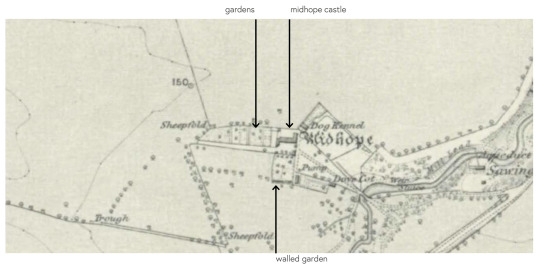
MASTERPLAN APPROACH
The current application is the first in a series of planned phased pro- posals for the site that will initially improve the setting, and stabilise the fabric, of the castle, and later seek to reuse and regenerate the castle.
The construction of the distillery and the production of the whisky need to be the first steps in order to establish the business and generate income in order to progress to the next phases of the wider project.
In the medium term there are also plans to open parts of the castle to facilitate some of visitors who currently visit the site due to the castle’s association with the “Outlander” television series.
There is the ultimate aim to use the castle for visitor functions that are complimentary to the new distillery – tasting spaces, dining, and potentially overnight accommodation.
All of these future works will carefully balance the repair and refur- bishment of the existing historical fabric of the castle and surround- ing landscape features. Further refinement of the timing and content of these next phases will reviewed as the project develops.

VISION
Initial works
The current Planning Application is for the new distillery building together with the immediate landscaping, a new access road and the change of use of Midhope Castle to visitor accommodation.
An application for Listed Building Consent will follow. This will include the repair and refurbishment works to the landscape features around the castle- the reinstatement of the damaged stone piers, the re- gaining of the walled garden and cobbled castle forecourt and the potential removal of derelict outbuildings. It has not been possible to gain access to the site to carry out these surveys due to restrictions imposed by the Covid 19 crisis.
Next steps
Future Planning Applications and Listed Building Applications are planned as the business becomes established. These include plans for a Maltings Building at the former Sawmill site, work to the castle and extensions as appropriate, repurposing of the Dovecot, and other facilities in the grounds of the castle and distillery.
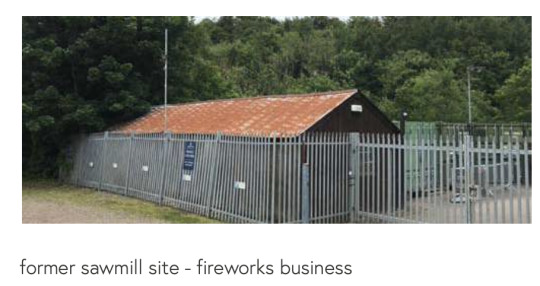

SCOPE OF INITIAL PHASE
It is possible to conceptually divide the site into two areas, they can broadly be described as modern farm building land and the castle grounds. It is not intended that the physical distinction between the areas be over emphasised in the finished design but it is a useful tool in describing the approaches to the specific areas. The distillery is proposed to be on the farm building land, with the main road and the access road coming across the castle grounds.
The farm building land does not have any obvious structures of histor- ic significance, whilst the castle grounds are rich with elements that are historically significant and referred to in the category A listing of the castle and the Category B listing of the Doocot.
The historic influence on the farm building land is most strongly ap- parent in its relationship to the castle grounds. The land spreads in
a relatively level expanse from the castle and forms the base of an approximate bowl. This reinforces the sense that the area that will house the distillery, despite being the larger area, is attendant on the castle as the most substantial historic structure on the site.
Very little work is proposed to the immediate castle grounds in this application. The client wishes to take the time to carefully consider the appropriate design and relationship with the existing buildings. The intention is to intervene in this area as little as possible at this point and only to the extent that is required to access the distillery site without negatively affecting the significant historic fabric.
The castle grounds are subject to ongoing analysis and will be the focus of future applications in subsequent phases.
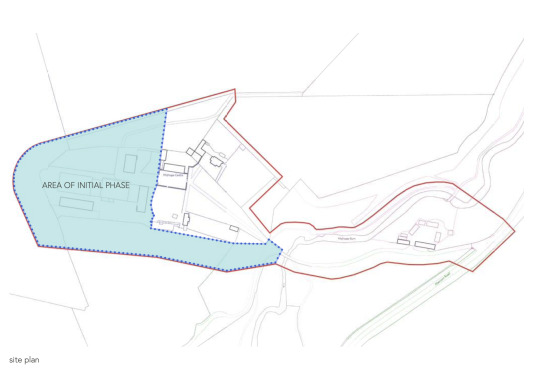
DESIGN PROPOSALS
The distillery is seens as the first phase of a sequence of develop- ments on the wider site aimed at enriching the landscape and improv- ing the setting and fabric of Midhope Castle.
The aspiration is to create a unique place where the production of Whisky, the landscape it draws from and the heritage of the site can be enjoyed. The setting and location is key to the proposal.
The new distillery building will have two main functions. It will pro- duce over 500,000 litres of whisky a year from Barley grown on the Estate. It will also offer visitors the opportunity to see all aspects of the Whisky production process and to enjoy the unique historical set- ting and landscape.
The setting of the distillery is one that has many layers of history. It will be close to Midhope Castle, which is known to date from the fif- teenth century and along with the land around has been altered many times over the subsequent years. The castle was occupied until the 1920s and each periodw has resulted in change. The additions to the castle are clear to see, and there are buildings around the castle that date from the 1800s. The setting shows a timeline of agricultural use and castle shows evidence of the varied occupation that ranges from aristocracy to the workers on the land.
The castle is the embodiment of the historic significance of the site, and this position is to be carefully maintained. The orientation of the new design is lead by the influence of the existing fabric. It’s form will have a larger footprint but a lower height, it will not compete with the castle but rather work alongside it, and by looking toward the castle’s raised entrance create an exciting new dynamic.

SETTING & ACCESS
The approach to the site will be along the existing track which winds through dense woodland to a clearing that is currently used as a car park for visitors to the castle.
From here a new access route is proposed to take service traffic for the distillery to the south, away from the castle and existing cottages.
The existing footpath leads up to the castle courtyard past the listed dovecot building and existing Victorian cottage and outbuildings to the north.
The courtyard sits between the castle and the overgrown walled gar- den to the south. To the west of this enclosed outdoor space is the open area currently given over to light industrial and agricultural use. This largely flat area of land sits within a shallow depression relative to the surrounding wider agricultural landscape. This will be the site of the new distillery.
The distillery begins to be visible on moving through the courtyard. The new building will align with the traces of an route that once ran through this area out to the west.

SETTING & RESPONSE
The new building consists of three, simple shed-like forms.
The largest is a long, pitched roof building that edges the south of the site. This building will contain most of the distillery production areas and spaces for visitors – a display area containing whisky ma- turing in barrels, tasting spaces, and multi-purpose areas that can be used for exhibitions and functions.
To the north is a second smaller pitched roof form that contains the stills and shelters the worm tubs.
To the south a third pitched roof form encloses external tanks and barrel storage.
A service yard is located to the south of the distillery and sits be- tween the new building and the existing embankment. The service yard and the more industrial activity is hidden from view from the surrounding landscape and most importantly is invisible from the ap- proach road and castle. Access to the service yard will be provided by a new road formed to the south of the main site.
The public areas of the distillery will offer views back to the castle and the landscape to the north. The landscape around the distillery will reinstate paths and routes that we once on the site.

DESIGN DEVELOPMENT
The basic form of the new building has been influenced by common simple, robust utilitarian agricultural buildings. From a distance the distillery will appear as a grouping of simple, quiet forms in the land- scape.
The still house will be wrapped in timber giving it an abstract quality. This building will contain the stills and their copper forms will be vis- ible through the glazed gable facing the castle courtyard.
The still house sits in a cooling pond and forms a gathering place at the visitor entrance to the distillery. This entrance aligns with both the reinstated road and wall running east to west but also with the existing track that leaves the site to the north.
A large framed window on the first floor of the distillery offers pano- ramic views back to the castle, across the structured landscape close to the distillery and further to the agriculutral fields of the estate beyond. These large windows will be edged in bronze metal cladding,
The maturation display area at the east end of the building will be clad in stained or charred slatted timber that will allow in direct light into the space. On dark evenings this end of the building will glow and act as a lantern drawing visitors across the landscape from the castle.
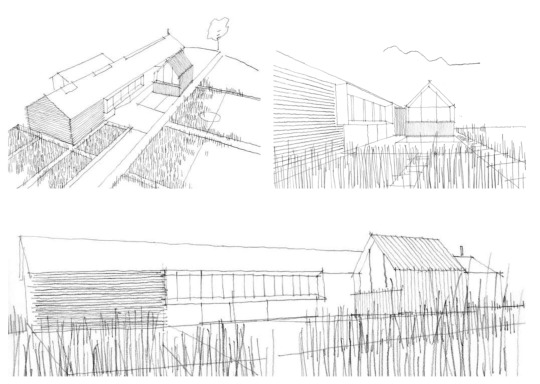




As I showed in my previous post, these plans are now revised and filed again on 8 February 2024, awaiting a decision. This document was filed on 21 March 2024. There are some minor changes to the original plans which were already approved in 2021
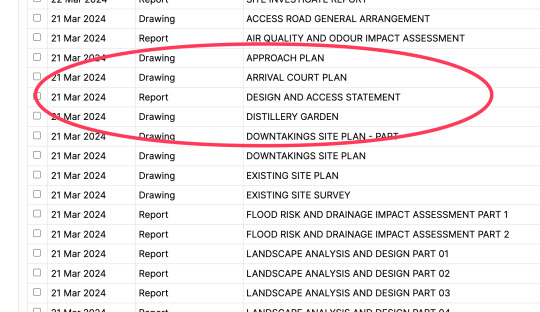
52 notes
·
View notes
Text
An introduction to VR passenger carriages, part 2: Eil commuter carriages
Like the blue carriages, the Eil and Eilf carriages are rare these days, with most of them having been scrapped. They are also close relatives to the blue carriages, and indeed some consider them to be blue carriages. However, as a colour-oriented person I never approved of this, as the Eils were never blue, but rather had a sexy unique look never shared by other carriages.

An Sr1-hauled commuter train made of Eil coaches at Hyvinkää, 1984. Mikko Lumio, Suomen rautatiemuseo.
The Eil carriages were built in 1982 and 1985-87 by our Pasila workshop in Helsinki (the last class of carriages built entirely in-house by us) primarily for use in the commuter services around Helsinki. Their arrival allowed us to retire the last wooden-bodied passenger coaches.
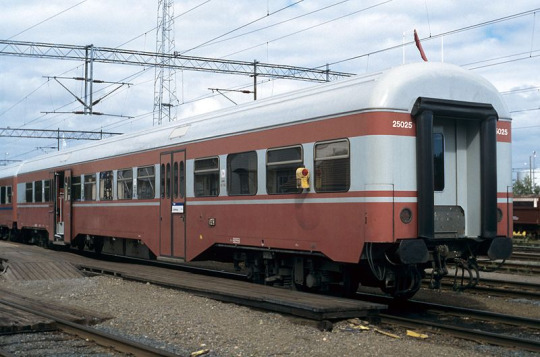
Eil 25025 at Joensuu in a long-distance train, 1995. Falk2, Wikimedia commons
Like all of our passenger carriages at the time, the Eils were designed in-house by our own design department. To facilitate fast loading and unloading, doors were moved from the ends of the carriage (as they were in all blue carriages) to the middle, and widened into double doors to allow double penetration - a construction very similar to the Sm1 and Sm2 electric multiple units already used in the Helsinki commuter services. Seating arrangements were also similar to the first two Sm series, with groups of six and four facing sets. However, the seats were fabric-upholstered individual seats to give better comfort and make the Eil carriages better suited to use in long-distance trains if needed. The carriages were given a unique livery, with similar stripes as on the blue carriages but using red instead of blue.

Interior of an Eil carriage, 2007. Psl10i, Wikimedia commons
The Eilf carriages were otherwise identical to plain Eil carriages, but had a space for the conductor. In total, 50 Eil:s and 7 Eilf:s were built. The original top speed of the carriages was 140 km/h, but this was upgraded to 160 km/h in the early 2000s. Starting from 2011, they were repainted in our current corporate image, unfortunately making them less easy to distinguish from long-distance trains.

A rake of Eil coaches at Kouvola in the current livery. Nimimerkki951, Wikimedia commons
With the delivery of new trains for use in the Helsinki commuter train network, the Eil-carriages were retired in 2017. They languished in layup until 2020, when some of them were reactivated for use in locomotive-hauled commuter trains. However, scrapping sorry, marketing department told us to say recycling also begun the same year, and at the time of writing only 16 Eils and 4 Eilfs survive. If you're lucky, you can still spot the attractive carriages filled by hot, sweating workers in Z and R trains during the rush hour.
27 notes
·
View notes
Text
On May 28, 1914, the Institut für Schiffs-und Tropenkrankheiten (Institute for Maritime and Tropical Diseases, ISTK) in Hamburg began operations in a complex of new brick buildings on the bank of the Elb. The buildings were designed by Fritz Schumacher, who had become the Head of Hamburg’s building department (Leiter des Hochbauamtes) in 1909 after a “flood of architectural projects” accumulated following the industrialization of the harbor in the 1880s and the “new housing and working conditions” that followed. The ISTK was one of these projects, connected to the port by its [...] mission: to research and heal tropical illnesses; [...] to support the Hamburg Port [...]; and to support endeavors of the German Empire overseas.
First established in 1900 by Bernhard Nocht, chief of the Port Medical Service, the ISTK originally operated out of an existing building, but by 1909, when the Hamburg Colonial Institute became its parent organization (and Schumacher was hired by the Hamburg Senate), the operations of the ISTK had outgrown [...]. [I]ts commission by the city was an opportunity for Schumacher to show how he could contribute to guiding the city’s economic and architectural growth in tandem, and for Nocht, an opportunity to establish an unprecedented spatial paradigm for the field of Tropical Medicine that anchored the new frontier of science in the German Empire. [...]
[There was a] shared drive to contribute to the [...] wealth of Hamburg within the context of its expanding global network [...]. [E]ach discipline [...] architecture and medicine were participating in a shared [...] discursive operation. [...]
---
The brick used on the ISTK façades was key to Schumacher’s larger Städtebau plan for Hamburg, which envisioned the city as a vehicle for a “harmonious” synthesis between aesthetics and economy. [...] For Schumacher, brick [was significantly preferable] [...]. Used by [...] Hamburg architects [over the past few decades], who acquired their penchant for neo-gothic brickwork at the Hanover school, brick had both a historical presence and aesthetic pedigree in Hamburg [...]. [T]his material had already been used in Die Speicherstadt, a warehouse district in Hamburg where unequal social conditions had only grown more exacerbated [...]. Die Speicherstadt was constructed in three phases [beginning] in 1883 [...]. By serving the port, the warehouses facilitated the expansion and security of Hamburg’s wealth. [...] Yet the collective profits accrued to the city by these buildings [...] did not increase economic prosperity and social equity for all. [...] [A] residential area for harbor workers was demolished to make way for the warehouses. After the contract for the port expansion was negotiated in 1881, over 20,000 people were pushed out of their homes and into adjacent areas of the city, which soon became overcrowded [...]. In turn, these [...] areas of the city [...] were the worst hit by the Hamburg cholera epidemic of 1892, the most devastating in Europe that year. The 1892 cholera epidemic [...] articulated the growing inability of the Hamburg Senate, comprising the city’s elite, to manage class relationships [...] [in such] a city that was explicitly run by and for the merchant class [...].
In Hamburg, the response to such an ugly disease of the masses was the enforcement of quarantine methods that pushed the working class into the suburbs, isolated immigrants on an island, and separated the sick according to racial identity.
In partnership with the German Empire, Hamburg established new hygiene institutions in the city, including the Port Medical Service (a progenitor of the ISTK). [...] [T]he discourse of [creating the school for tropical medicine] centered around city building and nation building, brick by brick, mark by mark.
---
Just as the exterior condition of the building was, for Schumacher, part of a much larger plan for the city, the program of the building and its interior were part of the German Empire and Tropical Medicine’s much larger interest in controlling the health and wealth of its nation and colonies. [...]
Yet the establishment of the ISTK marked a critical shift in medical thinking [...]. And while the ISTK was not the only institution in Europe to form around the conception and perceived threat of tropical diseases, it was the first to build a facility specifically to support their “exploration and combat” in lockstep, as Nocht described it.
The field of Tropical Medicine had been established in Germany by the very same journal Nocht published his overview of the ISTK. The Archiv für Schiffs- und Tropen-Hygiene unter besonderer Berücksichtigung der Pathologie und Therapie was first published in 1897, the same year that the German Empire claimed Kiaochow (northeast China) and about two years after it claimed Southwest Africa (Namibia), Cameroon, Togo, East Africa (Tanzania, Burundi, Rwanda), New Guinea (today the northern part of Papua New Guinea), and the Marshall Islands; two years later, it would also claim the Caroline Islands, Palau, Mariana Islands (today Micronesia), and Samoa (today Western Samoa).
---
The inaugural journal [...] marked a paradigm shift [...]. In his opening letter, the editor stated that the aim of Tropical Medicine is to “provide the white race with a home in the tropics.” [...]
As part of the institute’s agenda to support the expansion of the Empire through teaching and development [...], members of the ISTK contributed to the Deutsches Kolonial Lexikon, a three-volume series completed in 1914 (in the same year as the new ISTK buildings) and published in 1920. The three volumes contained maps of the colonies coded to show the areas that were considered “healthy” for Europeans, along with recommended building guidelines for hospitals in the tropics. [...] "Natives" were given separate facilities [...]. The hospital at the ISTK was similarly divided according to identity. An essentializing belief in “intrinsic factors” determined by skin color, constitutive to Tropical Medicine, materialized in the building’s circulation. Potential patients were assessed in the main building to determine their next destination in the hospital. A room labeled “Farbige” (colored) - visible in both Nocht and Schumacher’s publications - shows that the hospital segregated people of color from whites. [...]
---
Despite belonging to two different disciplines [medicine and architecture], both Nocht and Schumacher’s publications articulate an understanding of health [...] that is linked to concepts of identity separating white upper-class German Europeans from others. [In] Hamburg [...] recent growth of the shipping industry and overt engagement of the German Empire in colonialism brought even more distant global connections to its port. For Schumacher, Hamburg’s presence in a global network meant it needed to strengthen its local identity and economy [by purposefully seeking to showcase "traditional" northern German neo-gothic brickwork while elevating local brick industry] lest it grow too far from its roots. In the case of Tropical Medicine at the ISTK, the “tropics” seemed to act as a foil for the European identity - a constructed category through which the European identity could redescribe itself by exclusion [...].
What it meant to be sick or healthy was taken up by both medicine and architecture - [...] neither in a vacuum.
---
All text above by: Carrie Bly. "Mediums of Medicine: The Institute for Maritime and Tropical Diseases in Hamburg". Sick Architecture series published by e-flux Architecture. November 2020. [Bold emphasis and some paragraph breaks/contractions added by me. Text within brackets added by me for clarity. Presented here for commentary, teaching, criticism purposes.]
#abolition#ecology#sorry i know its long ive been looking at this in my drafts for a long long time trying to condense#but its such a rich comparison that i didnt wanna lessen the impact of blys work here#bly in 2022 did dissertation defense in architecture history and theory on political economy of steel in US in 20s and 30#add this to our conversations about brazilian eugenics in 1930s explicitly conflating hygiene modernist architecture and white supremacy#and british tropical medicine establishment in colonial india#and US sanitation and antimosquito campaigns in 1910s panama using jim crow laws and segregation and forcibly testing local women#see chakrabartis work on tropical medicine and empire in south asia and fahim amirs cloudy swords#and greg mitmans work on connections between#US tropical medicine schools and fruit plantations in central america and US military occupation of philippines and rubber in west africa
13 notes
·
View notes
Text
Though Section 31 is the most well-known secret organization within the Federation, there is another, with its roots in ancient Earth...
Item #: SCP-54973
Object Class: Euclid Keter
Special Containment Procedures: SCP-54973 is currently contained within a museum ship at the Fleet Museum at █████ █████. The sensor and security logs of the Fleet Museum are scanned for signs of SCP-54973-1 every two nanoseconds by a discreet Foundation algorithm. Upon detection of a SCP-54973-1 instance, Foundation fightercraft are to be dispatched and intercept the object before it can advance to warp. Intercepted instances are to be destroyed or tractored to Foundation storage facility at the discretion of the administrator of Deep Space Site-15.
Visitors to the museum should be forbidden access to the ship's ninth deck, under a cover story of performing required renovations. Should anyone but approved researchers, ESCPH units, and D-series synths enter deck 9, they are to be detained and evaluated for memetic contamination before release. The starship's renown with the general public prevents fuller containment at this time.
Description: SCP-54973 is the primary shuttlebay of the decommissioned ████████-class starship USS ███████, NCC-█████. Anomalous properties were discovered upon the ship's return from a seven year journey in the [redacted], and the current procedures implemented.
At regular intervals, SCP-54973 produces shuttlecraft. The process by which new shuttlecraft are created is as of yet unknown, as SCP-54973 produces false records in all sensor and recording equipment placed within itself during a production event. Shuttlecraft are designated SCP-54973-1. Since the starship ███████'s return from the [redacted] and the departure of its crew, SCP-54973-1 instances have begun autonomously launching themselves into space by a unknown process and attempting a rapid acceleration to warp.
SCP-54973-1 instances resemble baseline Starfleet shuttlecraft externally, but their interiors have been made from a variety of non-standard substances, including wood, bio-neural gel, humanoid biological components, and [DATA EXPUNGED].
While in service in the [redacted], SCP-54973 exerted a strong memetic effect on its crew. Logs indicate frequent statements that ███████ had "a full complement of shuttles" no matter their losses (in reality, the starship's ordinary complement of shuttles was exhausted a little over a year into their mission). Crew additionally expressed no alarm at the anomalous nature of the shuttlecraft, or at the appearance of non-standard designs such as the "█████ █████", believing they had been constructed by the crew, despite the implausibility of constructing experimental shuttle designs with a paucity of resources.
Addendum 54973-A: On Stardate █████.█, a SCP-54973-1 instance was not intercepted in time and accelerated to Warp ██. Its current whereabouts are unknown. All ships and starbases within the territory of the Federation, Klingon Empire, Romulan Free State and other post-nova remnant governments, Nyberrite Alliance, Dominion, and I██████ Empire received a transmission in an artificial voice resembling that of ███████'s former Captain, ███████ ███████:
"I'm coming, babies. I'm coming, I'm almost back babies, I'm -"
Transmission intercepted by Foundation assets in each government before wider exposure. Meaning of transmission remains unknown.
In light of SCP-54973-1's warp ██ capabilities, upgrade to Keter suggested and approved.
48 notes
·
View notes
Note
Sydney Trains M set
Class of electric train operating in Sydney, Australia
The Sydney Trains M sets, also referred to as the Millennium trains, are a class of electric multiple units that operate on the Sydney Trains network. Built by EDi Rail between 2002 and 2005, the first sets initially entered service under the CityRail brand on 1 July 2002 after short delays due to electrical defects. The M sets were built as "fourth generation" trains for Sydney's suburban rail fleet, replacing the 1960s Tulloch carriages and providing extra capacity on the suburban rail network. The sets currently operate on the T2 Inner West & Leppington, T3 Bankstown, T5 Cumberland, T7 Olympic Park and T8 Airport & South lines.
Quick Facts M set, In service ...
M set
M32 at Sydney Central
Lower deck
In service
2002–present
Manufacturer
EDi Rail
Built at
Cardiff
Replaced
Tulloch carriages
Constructed
2002–2005
Entered service
1 July 2002
Number built
141 carriages
Number in service
140 carriages
Formation
35 4-car sets
Fleet numbers
D1001–D1041, D1043–D1060, D1062–D1073 (driving trailers)
N1501–N1540, N1543–N1560, N1562–N1573 (motor cars)
M1–M35 (full 4-car sets)
Capacity
452
Operators
Sydney Trains
Depots
Auburn
Lines served
Inner West & Leppington
Bankstown
Cumberland
Olympic Park
Airport & South
Specifications
Car body construction
Stainless steel
Train length
81.55 m (267 ft 6+5⁄8 in)
Car length
20,532 mm (67 ft 4+3⁄8 in) (D)
20,243 mm (66 ft 5 in) (N)
Width
3.03 m (9 ft 11+1⁄4 in)
Height
4,381 mm (14 ft 4+1⁄2 in)
Doors
Plug-style, 2 per side
Wheel diameter
940 mm (37 in)
Maximum speed
130 km/h (81 mph) (design)
115 km/h (71 mph) (service)
Weight
207 t (204 long tons; 228 short tons)
Traction system
Alstom ONIX 1500 2-level IGBT–VVVF
Traction motors
8 × Alstom 4-EXA-2144 226 kW (303 hp) 3-phase AC induction motor
Power output
1,808 kW (2,425 hp)
Electric system(s)
1,500 V DC (nominal) from overhead catenary
Current collector(s)
Pantograph
UIC classification
2′2′+Bo′Bo′+Bo′Bo′+2′2′
Braking system(s)
Automatic air, electropneumatic and regenerative
Coupling system
Scharfenberg coupler
Track gauge
1,435 mm (4 ft 8+1⁄2 in) standard gauge
Close
Design
Vestibule
The Millennium train, like the entire Sydney Trains fleet and electric NSW TrainLink fleet, is a double decker. It is a four car consist, with the middle two cars being non-control motor cars and the two outer cars being driving control trailer cars fitted with the pantograph. The Millennium train was the first to be equipped with an AC drive system unlike the Tangara, which has a DC drive system. The sets usually operate in eight-car formations with two four-car sets combined. While the Millennium train concept is an evolution of the Tangara concept (manufactured by A Goninan & Co), the Millennium train introduced new features such as internal electronic destination indicators, automated digital voice announcements for upcoming stops, a return to reversible seating, surveillance cameras, wider stairways, a new safety yellow colour scheme, and push-button opened internal doors. The Millennium Train also introduced crumple zones to absorb impact in a collision. Interiors were designed by Transport Design International.
The train also features emergency help points, allowing passengers to contact the train crew in an emergency. The help points are located on the sides of the stairwell to the upper deck. There are actually two help points in the same location, with a large one at face height with a microphone and speaker, and a lower one with a microphone only. There are also emergency door releases which were retrofitted to the trains. These allow passengers to manually open the doors in an emergency, as recommended in the report for the Waterfall rail accident. The retrofit program was stated as having been completed in November 2014.
Like with the T, A and B sets, the M sets feature Scharfenberg couplers.
M sets are 3.03 metres (9 ft 11+1⁄4 in) wide, being classed by Transport for NSW as medium width trains, which allows them to operate within the whole Sydney Trains suburban network.
Unlike sets M2–M35, set M1 has a slightly different interior design with differently coloured doors and different seat handles for unknown reasons.
Delivery
Stairwell
The cars were constructed by EDi Rail at Cardiff Workshops. The contract included a 15-year maintenance agreement with EDi Rail to maintain the trains at a specialised maintenance centre at Eveleigh. During testing and initial revenue service, they ran as four car sets, with eight car sets commencing service towards the end of 2002 after further testing. All 35 four car sets were delivered by October 2005.
The initial order signed in October 1998 was for 81 carriages, in December 2002 an option was taken up for an additional 60. In February 2017, Sydney Trains exercised an option to extend Downer's maintenance of the trains for a further 10 years.
Criticisms
The Millennium trains were criticised for having several technical problems and causing problems with Sydney Trains, they were referred to in the media reports as The "Mi-lemon" and "Millenni-Bug" as a result. Some of the problems were caused by insufficient power supply on the overhead to cope with the power demands of the more technologically advanced trains causing them to shut down. Software bugs also contributed to the trains' poor reliability.
The Millennium trains were withdrawn from service in April 2003 while the problems were being rectified and a full audit was carried out. They were subsequently reintroduced into service in June 2003 and have since been operating on the T2 Inner West & Leppington, T3 Bankstown, T6 Carlingford, T7 Olympic Park and T8 Airport & South lines. After the new timetable was released on 26 November 2017, M sets began as 4-car services on the T5 Cumberland line on both weekdays & weekends, along with a few 8-car Waratahs.
In service
External Carriage Camera Trial
Trial cameras
In late 2008, two Millennium trains were fitted with external cameras atop of carriages near the doors, testing their use for the then-future Waratah trains. These cameras were subsequently incorporated into the final design of the Waratah train.
Lines serviced
The Millennium trains typically operate on the following lines (normally described as Sector 2):
T2 Inner West & Leppington Line: Leppington or Parramatta to City Circle via Granville
T3 Bankstown Line: Liverpool or Lidcombe to City Circle via Bankstown
T5 Cumberland Line: Leppington to Richmond
T7 Olympic Park Line: Shuttle from Lidcombe to Olympic Park on weekdays
T8 Airport & South Line: Macarthur to City Circle via Airport or Sydenham
Maintenance Depots
The trains were originally maintained at Eveleigh Maintenance Centre.
As with all other trains, these trains are not exclusively kept in Auburn overnight. They only need to return to the depot for maintenance, and at other times, they may be stabled at various yards on the lines that they operate, such as Liverpool and Leppington yards -Anastasia the train girl
I won���t be able to post as much cause mental issues plus I just came out to a friend as trans so I have to deal with that to
sorry for taking so long to respond! I've been busy lately.
9/10 good train (minus the bugs)
(also i hope all goes well for you! I enjoy your train asks, but don't feel bad if you don't want to send them as often.)
#trains#this one was cool#it seemed to sort of introduce concepts that were perfected for modern trains#so that's cool
3 notes
·
View notes
Text
Modern Design Area Rug Designer Artful Easy Care Uniquely Carpets for Living Space
Welcome to Warmly Home!
Awesome Modern Design Area Rug!
Online Rug Store with Excellent Service!
New Design, New Trends, and New Ideas!
Interior Design Inspiration and Home Decor Items!
Enjoy your online shopping time!
Product: Modern Design Area Rug
Feature: Durable and Easy To Clean
Style: Modern Unique Colored Design
Technique: Power Loom
Construction: Machine-Made
Main Material: Front:…

View On WordPress
3 notes
·
View notes